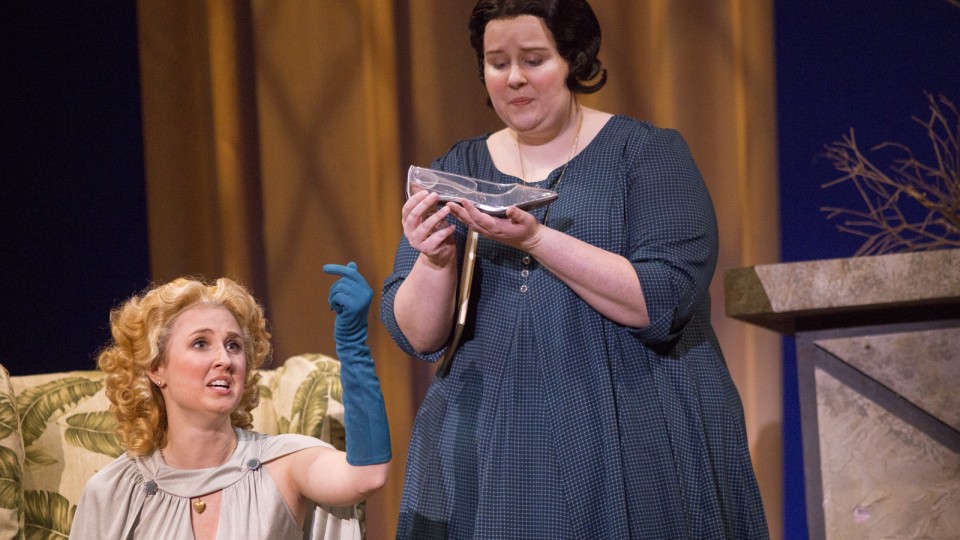· 4 min read
Opera offers spin on classic Cinderella story

The UNL opera program will present Jules Massenet’s “Cendrillon” — a spin on the classic tale of Cinderella — on Feb. 21 and 23. The performances are directed by William Shomos, professor of voice and director of the opera program.
Performances are 7:30 p.m. Feb. 21 and 3 p.m. Feb. 23 in Kimball Recital Hall. Tickets are $20 for adults and $10 for students and senior citizens. Tickets are available at the Lied Center for Performing Arts box office or by calling 402-472-4747.
“Cendrillon” is described as a fairy tale in four acts by Massenet. It is based on Charles Perrault’s 1698 version of the Cinderella fairy tale. It will be performed in French with supertitles, but Shomos said it is entirely family friendly.
“If you know the Cinderella story, you’re going to be able to follow what’s going on,” Shomos said.
Many are familiar with either the Disney or Rodgers and Hammerstein versions of Cinderella. The opera version includes the fairy godmother who transforms Cinderella and gives her a glass slipper and a midnight curfew.
Massenet’s opera also has three major differences from those versions. One, Cinderella’s father is still alive in the opera. The other difference is the treatment of Cinderella by the stepmother and stepsisters.
“They’re not portrayed sympathetically at all,” Shomos said. “On the other hand, they aren’t terribly mean to Cinderella, either. They just neglect and ignore her.”
The third difference is a scene that takes place by an oak tree following the ball. When the stepmother and stepsisters return from the ball, they talk about the event.
“Arriving home after the ball, the piece of information the stepmother relates to Cinderella is that after the mysterious woman (Cinderella) ran off at the stroke of midnight, the prince came to his senses, declaring to the guests that she was a worthless trollop,” Shomos said. “Well, the stepmother is lying, but Cinderella doesn’t know that, and she is devastated.”
Cinderella goes off on her own and appears almost to give up on life. She ends up at an oak tree, where the fairy godmother lives.
“All of a sudden, the story takes on a weird dream-like character,” Shomos said.
The prince is also at the oak tree, but the two cannot look at each other. They eventually recognize each other’s voices. When the fairy godmother allows them to see each other, Cinderella falls asleep.
“It’s open to a lot of interpretation,” Shomos said. “When she wakes up, her father tells her she has been dreaming.”
The ambiguity of the odd oak tree scene inspired Shomos to take some imaginative latitude in his staging concept, so he has cast two different Cinderellas.
“As a father of girls, the one thing that drives me nuts about the Cinderella story is that even though we all know she is beautiful at heart, the only way she’s actually accepted into society is when she gets the nice dress and she becomes the beauty queen-type,” Shomos said. “That bothered me.”
He decided to explore having both conventional and unconventional halves of Cinderella.
“I wanted to challenge our audience to ask, ‘What are our preconceived ideas of what Cinderella is?’” Shomos said. “If you ask anyone on the street, ‘Is inner beauty more important that outer beauty?’ We’re all going to say yes. But what is physical beauty? Whether we like it or not, we still have this idea that beauty is a certain kind of model that one sees on the cover of magazines. And we all try to say that’s not the way it is, but the media pushes those images at us so much, I think it’s difficult to deny the influence.”
Second-year master of music student Jamie Unger as the conventional Cinderella, while Alexandra Tiller, a senior vocal performance major, plays the unconventional type role.
“Sometimes they’re in dialogue with each other, in words or in action,” Shomos said. “But they are the same person. They feel the same things at the same time. And just like human beings, sometimes we are of two minds, and sometimes those two minds are in support of each other and sometimes we’re at odds with ourselves.”
Shomos said, “Both of my Cinderellas are very beautiful.”
The opera will also be set in the 1930s and is designed by two graduate students in the Johnny Carson School of Theatre and Film. David Tousley is the set designer, and Clay Van Winkle is the lighting designer. The orchestra will be directed by Tyler White, professor of music.







